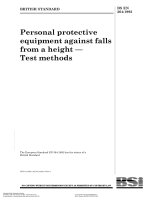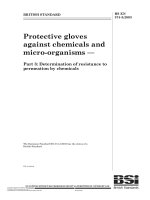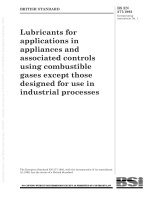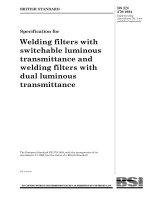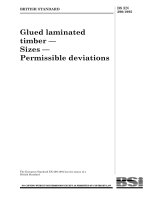Bsi bs en 12006 3 1999
Bạn đang xem bản rút gọn của tài liệu. Xem và tải ngay bản đầy đủ của tài liệu tại đây (104.97 KB, 10 trang )
Licensed Copy: sheffieldun sheffieldun, na, Sat Oct 28 14:48:38 GMT+00:00 2006, Uncontrolled Copy, (c) BSI
BRITISH STANDARD
Non-active surgical
implants Ð Particular
requirements for cardiac and
vascular implants Ð
Part 3: Endovascular devices
The European Standard EN 12006-3:1998 has the status of a
British Standard
ICS 11.040.40
NO COPYING WITHOUT BSI PERMISSION EXCEPT AS PERMITTED BY COPYRIGHT LAW
|
|
|
|
|
|
|
|
|
|
|
|
|
|
|
|
|
|
|
|
|
|
|
|
|
|
|
|
|
|
|
|
|
|
|
|
|
|
|
|
|
|
|
|
|
|
|
|
|
|
|
|
|
|
|
|
|
|
|
|
|
|
|
|
|
|
|
|
|
|
|
|
|
|
|
|
|
|
|
|
|
|
|
|
|
|
|
|
|
|
|
|
|
|
|
|
|
|
|
|
|
|
|
|
|
|
|
|
|
|
|
|
|
|
|
|
|
|
|
|
|
|
|
|
|
|
|
|
|
BS EN
12006-3:1999
BS EN 12006-3:1999
National foreword
Licensed Copy: sheffieldun sheffieldun, na, Sat Oct 28 14:48:38 GMT+00:00 2006, Uncontrolled Copy, (c) BSI
This British Standard is the English language version of EN 12006-3:1998.
The UK participation in its preparation was entrusted to Technical Committee
CH/23, Cardiovascular implants, dialysis systems and oxygenators, which has the
responsibility to:
Ð aid enquirers to understand the text;
Ð present to the responsible European committee any enquiries on the
interpretation, or proposals for change, and keep the UK interests informed;
Ð monitor related international and European developments and promulgate
them in the UK.
A list of organizations represented on this committee can be obtained on request to
its secretary.
Cross-references
The British Standards which implement international or European publications
referred to in this document may be found in the BSI Standards Catalogue under the
section entitled ªInternational Standards Correspondence Indexº, or by using the
ªFindº facility of the BSI Standards Electronic Catalogue.
A British Standard does not purport to include all the necessary provisions of a
contract. Users of British Standards are responsible for their correct application.
Compliance with a British Standard does not of itself confer immunity
from legal obligations.
Summary of pages
This document comprises a front cover, an inside front cover, the EN title page,
pages 2 to 7 and a back cover.
This British Standard, having
been prepared under the
direction of the Health and
Environment Sector Committee,
was published under the
authority of the Standards
Committee and comes into effect
on 15 March 1999
BSI 03-1999
ISBN 0 580 30888 X
Amendments issued since publication
Amd. No.
Date
Text affected
EN 12006-3
EUROPEAN STANDARD
NORME EUROPEÂENNE
Licensed Copy: sheffieldun sheffieldun, na, Sat Oct 28 14:48:38 GMT+00:00 2006, Uncontrolled Copy, (c) BSI
EUROPAÈISCHE NORM
November 1998
ICS 11.040.40
Descriptors: medical devices, medical equipment, surgical implants, cardiac valves, vascular stents, filters, specifications,
corrosion resistance, fatigue life, dimensions, design, materials, manufacturing, sterilization, packing, instructions
English version
Non-active surgical implants Ð Particular requirements for cardiac
and vascular implants Ð Part 3: Endovascular devices
Implants chirurgicaux non-actifs Ð Exigences
particulieÁres relatives aux implants cardiaques et
vasculaires Ð Partie 3: Dispositifs endovasculaires
Nichtaktive chirurgische Implantate Ð Besondere
Anforderungen an Herz- und GefaÈûimplantate Ð
Teil 3: EndovaskulaÈre Implantate
This European Standard was approved by CEN on 8 November 1998.
CEN members are bound to comply with the CEN/CENELEC Internal Regulations
which stipulate the conditions for giving this European Standard the status of a
national standard without any alteration. Up-to-date lists and bibliographical
references concerning such national standards may be obtained on application to
the Central Secretariat or to any CEN member.
This European Standard exists in three official versions (English, French, German).
A version in any other language made by translation under the responsibility of a
CEN member into its own language and notified to the Central Secretariat has the
same status as the official versions.
CEN members are the national standards bodies of Austria, Belgium, Czech
Republic, Denmark, Finland, France, Germany, Greece, Iceland, Ireland, Italy,
Luxembourg, Netherlands, Norway, Portugal, Spain, Sweden, Switzerland and
United Kingdom.
CEN
European Committee for Standardization
Comite EuropeÂen de Normalisation
EuropaÈisches Komitee fuÈr Normung
Central Secretariat: rue de Stassart 36, B-1050 Brussels
1998 CEN All rights of exploitation in any form and by any means reserved worldwide for CEN national
Members.
Ref. No. EN 12006-3:1998 E
Licensed Copy: sheffieldun sheffieldun, na, Sat Oct 28 14:48:38 GMT+00:00 2006, Uncontrolled Copy, (c) BSI
Page 2
EN 12006-3:1998
Foreword
This European Standard has been prepared by
Technical Committee CEN/TC 285, Non-active surgical
implants, the Secretariat of which is held by NNI.
This European Standard shall be given the status of a
national standard, either by publication of an identical
text or by endorsement, at the latest by May 1999, and
conflicting national standards shall be withdrawn at
the latest by May 1999.
This European Standard has been prepared under a
mandate given to CEN by the European Commission
and the European Free Trade Association, and
supports essential requirements of EU Directive(s).
For relationship with EU Directive(s), see informative
annex C, which is an integral part of this standard.
There are three levels of European Standards dealing
with non-active surgical implants. These are as follows,
with level 1 being the highest:
Level 1: General requirements for non-active surgical
implants.
Level 2: Particular requirements for families of
non-active surgical implants.
Level 3: Specific requirements for types of non-active
surgical implants.
This standard is a level 2 standard and contains
requirements that apply to all non-active surgical
implants in the family of vena cava filters and vascular
stents.
The level 1 standard contains requirements that apply
to all non-active surgical implants.
Level 3 standards contain requirements that apply to
specific types of implants within a family.
To address all requirements, it is necessary to start
with a standard of the lowest available level.
References can also be found in annex A of this
standard.
According to the CEN/CENELEC Internal Regulations,
the national standards organizations of the following
countries are bound to implement this European
Standard: Austria, Belgium, Czech Republic, Denmark,
Finland, France, Germany, Greece, Iceland, Ireland,
Italy, Luxembourg, Netherlands, Norway, Portugal,
Spain, Sweden, Switzerland and the United Kingdom.
Contents
Foreword
1 Scope
2 Normative references
3 Definitions
4
Intended performance
5
Design attributes
6
Materials
7
Design evaluation
8
Manufacturing
9
Sterilization
10
Packaging
11
Information supplied by the
manufacturer
Annex A (informative) Bibliography
Annex B (informative) Animal studies with
stents
Annex C (informative) Clauses of this
European Standard addressing essential
requirements or other provisions of EU
Directives
Page
2
3
3
3
3
3
3
4
5
5
5
5
6
6
7
BSI 03-1999
Licensed Copy: sheffieldun sheffieldun, na, Sat Oct 28 14:48:38 GMT+00:00 2006, Uncontrolled Copy, (c) BSI
Page 3
EN 12006-3:1998
Introduction
3 Definitions
This European Standard, in addition to EN ISO 14630,
provides a method to demonstrate compliance with the
relevant Essential Requirements as outlined in general
terms in Annex 1 of the Council Directive 93/42/EEC of
14 June 1993 concerning medical devices, as they apply
to endovascular devices.
For the purpose of this standard the definitions of
EN ISO 14630 apply together with the following.
1 Scope
3.2
vena cava filter
implantable expanding filtering device to be inserted
into the vena cava
This European Standard specifies particular
requirements for endovascular devices.
With regard to safety, this standard gives, in addition to
EN ISO 14630, requirements for intended performance,
design attributes, materials, design evaluation,
manufacturing, sterilization, packaging and information
supplied by the manufacturer.
NOTE 1 Vascular occluders are not addressed in this standard.
For the time being the requirements as stated in
EN ISO 14630:1997 apply for these products.
NOTE 2 Due to the variations in the design of the implants
covered by this standard and in some cases due to the relatively
recent development of some of these implants, acceptable
standardized in vitro tests and long term results of clinical trials
are not always available.
Where no test method is described in this standard a complete
description of the validated test method and sample preparation
procedure used should be documented by the manufacturer. With
regard to design evaluation, where a specific standardized test is
not described, guidance is given by referring to current scientific
literature (see annex A). This standard aims to ensure that
manufacturers will address all aspects of design evaluation that
relate to the safety of the product. As further scientific and
clinical data become available, appropriate revision of the
standard will be necessary.
3.1
vascular stent
implantable expandable tubular structure supporting a
vascular conduit
3.3
stented graft
a combination of one or more stents and a tubular
graft
4 Intended performance
The requirements of EN ISO 14630:1997, clause 4 apply.
5 Design attributes
www.bzfxw.com
2 Normative references
This European Standard incorporates by dated or
undated reference, provisions from other publications.
These normative references are cited at the
appropriate places in the text and the publications are
listed hereafter. For dated references, subsequent
amendments to or revisions of any of these
publications apply to this European Standard only
when incorporated in it by amendment or revision. For
undated references the latest edition of the publication
referred to applies.
EN ISO 14630:1997, Non-active surgical implants Ð
General requirements.
(ISO 14630:1997)
ISO 10555-4, Sterile, single-use intravascular
catheters Ð Part 4: Balloon dilatation catheters.
BSI 03-1999
The requirements of EN ISO 14630:1997, clause 5 apply
together with the following:
a) oxidation-potential, the possibility of crevice
corrosion, passivation level (see 7.1.3) over the
relevant parts;
b) with regard to wear: fretting corrosion (see 7.1.2);
c) interface between implant and body (see
clause 7):
1) fixation hooks if present;
2) relative movement between implant and tissue;
3) forces exerted by the device on the surrounding
tissue;
4) forces required to deform the device if the
deformation is permanent;
d) expected ingrowth, penetration, perforation, tilting
and migration (see clause 7);
e) effects by flow pattern and release of ions
(see 7.1.3);
f) introduction and delivery systems (see 7.1.4);
g) geometry (see clause 7).
6 Materials
The requirements of EN ISO 14630:1997, clause 6 shall
apply.
Page 4
EN 12006-3:1998
Licensed Copy: sheffieldun sheffieldun, na, Sat Oct 28 14:48:38 GMT+00:00 2006, Uncontrolled Copy, (c) BSI
7 Design evaluation
The requirements of EN ISO 14630:1997, clause 7 shall
apply together with the following.
NOTE The effects of MRI on the implant should be evaluated
during the risk analysis.
7.1 General
Where no test method is described in this standard,
description of the validated test method and sample
preparation used in the study shall be documented by
the manufacturer. The need for a reference device shall
be considered. The method chosen including the
choice of the reference device shall be justified.
Data are required for a finite element or other stress
analysis that identifies the peak stresses in the device
when subjected to a worst-case physiological load. The
amounts of residual stress shall be determined and
accounted for when calculating safety factors.
7.1.1 Structural integrity testing
The anticipated deformation profile shall be
determined. For self expanding stents the forces
exerted by the device on the arterial wall shall be
determined.
7.1.2 Fatigue analysis
An in-depth analysis of the implant's fatigue resistance
shall be performed to ensure that the arterial/venous
implant conditions to which the device will be
subjected will not result in device failure.
When in vitro-testing is used as the primary method to
evaluate fatigue, analysis to determine the device
fatigue at 10 years equivalent real time should be
conducted on a statistically significant sample of
devices and dynamically cycled over simulated vessel
conditions.
NOTE Guidance can be found in A.1.
7.1.3 Oxidation potentials
The implant shall undergo potential measurement.
NOTE 1 Guidance can be found in A.2.
NOTE 2 Where several materials are used the manufacturer
should provide proof of their compatibility in terms of oxidation
potential.
7.1.4 Device/catheter system
The device/catheter system shall be tested to
demonstrate that it can deliver the device to the
intended location and that the device is not adversely
affected by the catheter. Where a balloon catheter is
used it shall comply with ISO 10555-4.
7.1.5 Surface
The implant shall be free from defects when examined
as follows:
a) examine the implant visually with normal sight for
process or surface defects;
b) examine the surface, hooks and other appropriate
aspects of the stent with a magnifier for process or
surface defects;
NOTE 1 Magnification of 32.5 to 5 is recommended.
c) examine particularly exposed areas of the implant
under magnification greater than that used in b).
NOTE 2 Magnification of 320 to 50 is recommended.
7.2 Stents (self expandable and balloon
expandable)
7.2.1 Dimensions
At least the following dimensions shall be measured:
a) inner diameter after expansion in nominal
conditions. The measured values for internal
measurements shall be rounded down to the
next 0.1 mm (see clause 11);
b) outer diameter after expansion in nominal
conditions. The measured values for external
measurements shall be rounded up to the
next 0.1 mm (see clause 11);
c) length of the stent after expansion (see
clause 11). The length is the distance between the
two ends. The measured values for lengths shall be
rounded up to the next 1 mm.
NOTE Means for hooks and fixation mounted on the stent
should not be included when the outer diameter is measured.
7.2.2 Radial strength
The change in outer diameter as a function of external
circumferential pressure shall be determined.
7.3 Recoil testing for balloon expandable stents
The amount of elastic recoil shall be quantified 1 h
after expansion for each sized stent and this variable
shall be correlated with the stated dimension.
7.4 Vena cava filters
7.4.1 Dimensions
The geometry shall be verified against the design
specification (see clause 5). All measurements shall be
done in tension free conditions.
www.bzfxw.com
NOTE The diameter is the distance on the filter between the
vena cava fixation points.
7.4.2 Fixation within the vena cava
The fixation of the filter on the vena cava wall shall be
evaluated and details shall be provided, including
expected ingrowth, penetration and perforation.
NOTE Guidance can be found in A.3.
7.4.3 Filtration
A filtration test shall be conducted and the results shall
be documented.
NOTE Guidance can be found in A.4.
7.5 Covered stents or stented grafts
For stents using a synthetic covering it is necessary to
provide proof of their functionality in accordance with
the graft related standards, but under endovascular
application conditions.
7.6 Preclinical evaluation
The requirements of EN ISO 14630:1997, 7.2 shall apply.
The rationale for the preclinical evaluation and the
justification for carrying out or waiving of any tests
shall be documented. For novel devices animal testing
shall be conducted for a period of at least 6 months, in
order to evaluate acute complications and clinical
follow-up. The study shall include the largest and the
smallest size of the device as permitted by suitable
animal models.
NOTE Informative annex B provides guidance on animal studies
with coronary stents.
BSI 03-1999
Licensed Copy: sheffieldun sheffieldun, na, Sat Oct 28 14:48:38 GMT+00:00 2006, Uncontrolled Copy, (c) BSI
Page 5
EN 12006-3:1998
7.7 Clinical evaluation
The requirements of EN ISO 14630:1997, 7.3 shall apply.
The rationale whether or not a clinical investigation is
necessary shall be documented.
Devices for which no clinical data are available shall
be subjected to clinical investigation over a period of
at least 6 months.
NOTE For coronary stents recommendations as given by the
European Society of Cardiology should be considered.
A clinical investigation shall also be considered for
design changes intended to alter the nature of
interaction of the device with the body (e.g. attachment
mechanisms).
8 Manufacturing
The requirements of EN ISO 14630:1997, clause 8 shall
apply.
Verification that the requirements of 7.1.5 have been
met shall be demonstrated by inspection, visually and
under magnification.
11 Information supplied by the
manufacturer
The requirements of EN ISO 14630:1997, clause 11 shall
apply together with the following:
a) for vena cava filters: recommended diameter
range of the vena cava;
b) for stents: dimensions as specified in 7.2.1;
c) for recommended balloon/catheter systems:
appropriate information regarding the relationship
between balloon pressure and stent diameter
(see 7.2.2);
d) for stents non pre-mounted on the delivery
catheter instructions as to how the stent is to be
mounted on the catheter, including use of a crimping
device if appropriate;
e) if the access site is relevant for the safe
implantation of the device it shall be specified in the
labelling.
9 Sterilization
Endovascular devices shall be supplied sterile. The
requirements of EN ISO 14630:1997, 9.1 and 9.3 apply.
10 Packaging
www.bzfxw.com
The requirements of EN ISO 14630:1997, clause 10 shall
apply.
BSI 03-1999
Licensed Copy: sheffieldun sheffieldun, na, Sat Oct 28 14:48:38 GMT+00:00 2006, Uncontrolled Copy, (c) BSI
Page 6
EN 12006-3:1998
Annex A (informative)
Bibliography
A.1 Fatigue analysis
J.M. Neurenburg, R.W. GuÈnther, E. Rassmussen
e.a. New retrievable percutaneous vena cava filters:
experimental in vitro and in vivo evaluation. In:
Cardiovasc Intervent Radiol 16, page 224, 1993.
S.V. Lossef, R.J. Lutz, J. Mundorf et al. Comparison of
mechanical deformation properties of metallic stents
with use of stress-strain analysis. In: JVIR 5,
page 341, 1994.
H. Bjarnason, J.W. Yedlicka, D.W. Hunter et al. In vitro
metal fatigue testing of inferior vena cava filters. In:
Investigative radiology 9, page 817, 1994.
C.D. Becker, H.M. Hoogewoud, P. Felder et al.
Long-term follow-up of the GuÈnther basket inferior
vena cava filter: Does mechanical instability cause
complications? In: Cardiovasc Intervent Radiolo 17,
page 247, 1994.
L.J. Greenfield, M.A. Savin. Comparison of titanium and
stainless steel Greenfield vena caval filters. In:
Surgery 106, page 820, 1989.
J.K. Burks, W.A. Peck. In: Science 199,
pages 542±544, 1978.
G. Villars. Atlas d'equilibres Electrochimiques,
Paris 1963.
A.2 Oxidation potentials
NFS 91-141: 1991, Biodegradability of dental alloys Ð
Standardization of electrochemical test.
A.3 Fixation of the filter within the vena cava
Thomas M. Vesley, M.D. Technical problems and
complications associated with inferior vena cava filters.
In: Seminars in interventional radiology, volume 11,
no. 2, June 1994.
F. Hammer, H. Rousseau, F. Joffre, B. Sentenac,
T. Tran-Van, R. Barthelemy e.a. In vitro evaluation of
vena cava filters. In: JVIR 5, page 869, 1994.
C.D. Korbin, R.A. Reed, F.C. Taylor et. al. Comparison
of filters in an oversized vena cava phantom: intracaval
placement of a bird's nest filter versus biliac placement
of Greenfield, Vena Tech-LGM and Simon ritinol filters.
In: JVIR 5, page 341, 1994.
A.4 Filtration
J.M. Neurenburg, R.W. GuÈnther, E. Rassmussen e.a.
New retrievable percutaneous vena cava filters:
experimental in vitro and in vivo evaluation. In:
Cardiovasc Intervent Radiol 16, page 224, 1993.
A.A. Katsamouris, A.C. Waltman, M.A. Delichatsios e.a.
Inferior Vena Cava filters: In vitro comparison of clot
trapping and flow dynamics. In: Radiology, Volume 166,
No. 2, pages 361±366, February 1988.
C.D. Korbin, R.J. Van Allan, R.T. Andrews e.a. Strut
interlocking of titanium Greenfield Vena Cava Filters
and its effect on clot capturing: an in vitro study. In:
Cardiovasc Intervent Radiol, pages 204±206, 1994.
J.D. Robinson, M.T. Madison, D.W. Hunter
e.a. Technical notes. In vitro evaluation of caval filters.
In: Cardiovasc Intervent Radiol 11, pages 346±351, 1988.
J-L. Kraimps, D. de La Faye, J. Drouineau e.a. Optimal
central trapping (OPCETRA) vena caval filter: results
of experimental studies. In; JVIR 3, page 697, 1992.
E.J. Ferris, T.C. McCowan, D.K. Carver,
e.a. Percutaneous inferior vena cava filters: follow up
of seven designs in 320 patients. In: Radiology 188,
page 851, 1993.
C.D. Korbin, R.A. Reed, F.C. Taylor e.a. In vitro flow
phantom analysis and clot-capturing ability of
incompletely opened vena tech-LGM vena cava filters.
In: Cardiovasc Intervent Radiol 16, page 3, 1993.
S.F. Millward, J.I. Marsh, C. Pon et. al.
Thrombus-trapping efficiency of the LGM (Vena Tech)
and titanium Greenfields filters in vivo. In: JVIR 3,
page 103, 1992.
M. Simon, D.J. Rabkin, S. Klesjinski et. al. Comparitive
evaluation of clinically available inferior vena cava
filters with an in vitro physiologic simulation of the
vena cava. In: Radiology 189, page 769, 1993.
F. Hammer, H. Rousseau, F. Joffre, B. Sentenac,
T. Tran- Van, R. Barthelemy e.a. In vitro evaluation of
vena cava filters. In: JVIR 5, page 869, 1994.
www.bzfxw.com
Annex B (informative)
Animal studies with stents
The purpose of animal studies is to evaluate the early
and late patency rates of the stent, the biological
reaction of the vessel and the performance of the
delivery catheter. A minimum of 25 stents should be
evaluated; however, sponsors should be aware of the
risks involved in too carefully limiting the number of
animal stents studied. More than one stent can be
implanted in an animal. The vessels selected for testing
shall have diameters similar to those proposed for
stent placement in the clinical trial. The smallest and
largest diameter stents shall be included in the animal
studies. Although normal vessels can be stented, it
does not necessarily follow that the stent will perform
similarly in atherosclerotic vessels. If an atherosclerotic
model is not evaluated, additional justification for the
device's intended use shall be provided.
BSI 03-1999
Licensed Copy: sheffieldun sheffieldun, na, Sat Oct 28 14:48:38 GMT+00:00 2006, Uncontrolled Copy, (c) BSI
Page 7
EN 12006-3:1998
The testing protocol(s), test results and study
conclusions should be fully described in order that an
independent evaluation of the conclusions can be
made. In addition to documenting all complications
occurring during the procedure and follow-up, the
following is required.
A. Study parameters
a) Provide a clear description of the pre-stenting
vessel characteristics, i.e. lumen diameter, versus
post-stenting and follow-up lumen diameter as
obtained from arteriography.
b) Describe the anti-coagulation therapy utilized in
the animal studies with respect to its similarity to
that proposed in the clinical trial.
c) Document the exact specifications of the stents
used, i.e. unexpanded diameter, length, expanded
diameter and inflation pressure.
d) Document the use of multiple stents at one lesion
location, if this will be permitted in the clinical trial.
B. Performance of the stents/delivery system
a) Preparation Ð the ease with which the device can
be prepared for use.
b) Introduction Ð the ability of the device to be
loaded on to the guidewire or into a guiding
catheter.
c) Pushability Ð the ability of the system to transmit
sufficient, even force proximally allowing for equal
and smooth movement distally.
d) Trackability Ð the ability of the system to
advance distally over a guidewire, following the
guidewire tip, along the path of the vessel, including
in narrow, tortuous vessels.
e) Flexibility Ð the ability of the stent/delivery
system to bend in order to accommodate a turn or
angle it is required to negotiate, and the flexibility of
the stent to conform to the vessel after the stent is
deployed.
f) Radiopacity Ð the visibility of the stent and
delivery system under fluoroscopy.
g) Inspection Ð a post-evaluation inspection to
document any evidence of damage to the delivery
system.
h) Accessories Ð a description of the performance
of all accessories recommended in the labelling such
as guiding catheters, haemostasis valves, sheaths, etc.
i) Investigator preference Ð a complete summary of
comments made by investigators regarding stent
performance.
C. Angiographic, haemodynamic and
histological results
a) Angiographic Ð determine flow characteristics of
the stented vessel immediately following stent
deployment and immediately prior to explantation.
b) Haemodynamic Ð determine if ECG or blood
pressure changes were noted during the implantation
period. Document any cases of distal embolization.
c) Histological
1) Measure the neointimal thickness at each
follow-up period throughout the stented length,
including at stent/artery junctions.
2) Document any occurrences of intravascular
trauma induced by stent placement in the vessel
of interest.
3) Provide a pathology report including gross
findings and microscopy studies involving both
conventional and scanning electron microscopic
techniques. The explanted vessel should be
evaluated for outer diameter enlargement, lumen
narrowing, filling defects, patency of side
branches, protrusions of the stent into the vessel
lumen and medical thinning.
4) Conduct a detailed examination of explanted
stents to document integrity.
Annex C (informative)
Clauses of this European Standard
addressing essential requirements or
other provisions of EU Directives.
This European Standard has been prepared under a
mandate given to CEN by the European Commission
and the European Free Trade Association and supports
essential requirements of EU directive 93/42/EEC of
June 14 concerning medical devices.
WARNING. Other requirements and other EU
Directives may be applicable to the product(s) falling
within the scope of this standard.
The following clauses for this standard are likely to
support requirements of Council Directive 93/42/EEC of
June 14 concerning medical devices.
Compliance with the clauses of this standard provides
one means of conforming with the specific essential
requirements of the Directive concerned and
associated EFTA regulations.
www.bzfxw.com
BSI 03-1999
Clauses/sub-clauses
of this European
Standard
4, 5, 6, 7, 8, 9, 10,
11
Corresponding
annex/paragraph
of Directive
(specify Directive
number,
e.g. 93/42/EEC)
Remarks
1, 2, 3, 4, 5, 7.1,
General: see
7.2, 7.3, 7.4, 7.5, 8, note 2 of
8.1, 8.2, 8.3, 8.4,
scope.
9.1, 9.2, 13.1, 14
Licensed Copy: sheffieldun sheffieldun, na, Sat Oct 28 14:48:38 GMT+00:00 2006, Uncontrolled Copy, (c) BSI
BSI
389 Chiswick High Road
London
W4 4AL
|
|
|
|
|
|
|
|
|
|
|
|
|
|
|
|
|
|
|
|
|
|
|
|
|
|
|
|
|
|
|
|
|
|
|
|
|
|
|
|
|
|
|
|
|
|
|
|
|
|
|
|
|
|
|
|
|
|
|
|
|
|
|
|
|
|
|
|
|
|
|
|
|
|
|
|
|
|
|
|
|
|
|
|
|
|
|
|
|
|
|
|
|
|
|
|
|
|
|
|
|
|
|
|
|
|
|
|
|
|
|
|
|
|
|
|
|
|
|
|
|
|
|
|
|
|
|
BSI Ð British Standards Institution
BSI is the independent national body responsible for preparing British Standards. It
presents the UK view on standards in Europe and at the international level. It is
incorporated by Royal Charter.
Revisions
British Standards are updated by amendment or revision. Users of British Standards
should make sure that they possess the latest amendments or editions.
It is the constant aim of BSI to improve the quality of our products and services. We
would be grateful if anyone finding an inaccuracy or ambiguity while using this
British Standard would inform the Secretary of the technical committee responsible,
the identity of which can be found on the inside front cover. Tel: 020 8996 9000.
Fax: 020 8996 7400.
BSI offers members an individual updating service called PLUS which ensures that
subscribers automatically receive the latest editions of standards.
Buying standards
Orders for all BSI, international and foreign standards publications should be
addressed to Customer Services. Tel: 020 8996 9001. Fax: 020 8996 7001.
In response to orders for international standards, it is BSI policy to supply the BSI
implementation of those that have been published as British Standards, unless
otherwise requested.
Information on standards
BSI provides a wide range of information on national, European and international
standards through its Library and its Technical Help to Exporters Service. Various
BSI electronic information services are also available which give details on all its
products and services. Contact the Information Centre. Tel: 020 8996 7111.
Fax: 020 8996 7048.
www.bzfxw.com
Subscribing members of BSI are kept up to date with standards developments and
receive substantial discounts on the purchase price of standards. For details of
these and other benefits contact Membership Administration. Tel: 020 8996 7002.
Fax: 020 8996 7001.
Copyright
Copyright subsists in all BSI publications. BSI also holds the copyright, in the UK, of
the publications of the international standardization bodies. Except as permitted
under the Copyright, Designs and Patents Act 1988 no extract may be reproduced,
stored in a retrieval system or transmitted in any form or by any means ± electronic,
photocopying, recording or otherwise ± without prior written permission from BSI.
This does not preclude the free use, in the course of implementing the standard, of
necessary details such as symbols, and size, type or grade designations. If these
details are to be used for any other purpose than implementation then the prior
written permission of BSI must be obtained.
If permission is granted, the terms may include royalty payments or a licensing
agreement. Details and advice can be obtained from the Copyright Manager.
Tel: 020 8996 7070.
